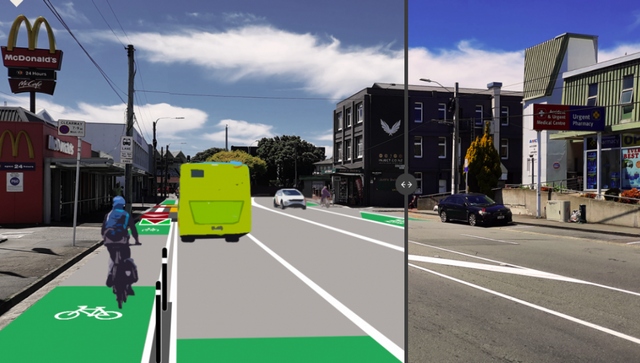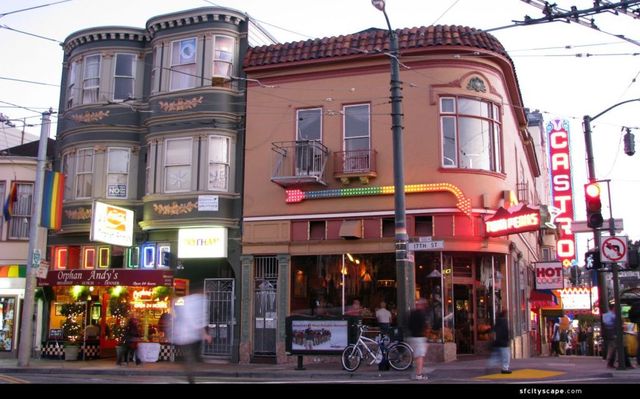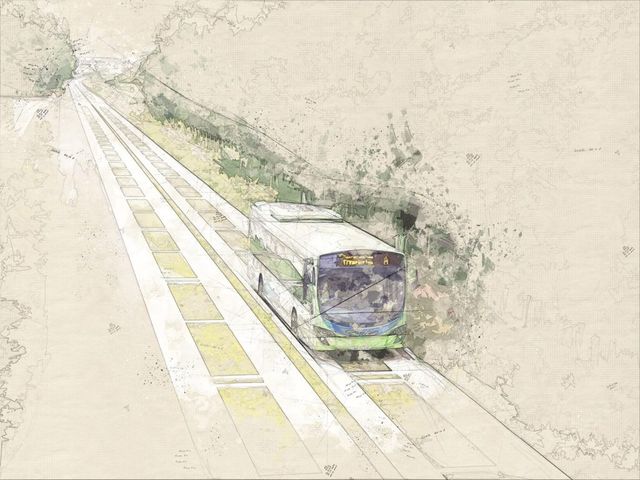Talk Wellington and Newtown
-
-

Smoother bussing and safer biking in Newtown? Now, or maybe not for a decade!
- Talk Wellington
- If you want a decently bikeable and more bus-friendly route between Newtown centre and the city, anytime within a decade, you need to give this a cheerful positive shove, now! Window closes this Wednesday! We have a partial separated cycleway and partial dedicated bus lanes in Newtown. Yes, you’ve probably submitted supportively on this before...
- Accepted from Talk Wellington posts by feedreader
- Tagged as:
- newtown
- island-bay-cycle-way
Newtown, Wellington, Wellington City, Wellington, New Zealand (OpenStreetMap)
-
-
-

Characterful medium density housing!
- Talk Wellington
- Who else is having conversations where someone goes “ooh but it’s all leaky soulless apartments, we don’t want that”? Here’s a feast for your eyes and balm for your worried soul Welcome to Talk Wellington’s random collection of neat medium-density examples to cheer you up, to show your friends, to tell the council you want … and to inspire density skeptics (presuming they’re in good faith, not just being awful). (Images’ links are in the image, caption or the text – click for more.) Enjoy! Characterful, “old”… medium density Montréal has a LOT of medium density residential neighbourhoods. They’re super liveable and beloved, and they are home to numbers of people that would sort out many of Wellington’s classic woes. Here’s some pretty historic-y medium density which has actual awesome neighbourhood vitality and character by the bucketload, for everyone. Medium density can be… no more than two storeys, with lots of mixed use and features like shop-top housing! No offence, Mt Vic / Khandallah / Thorndon / Woburn, but your neighbourhoods can’t hold a candle to the Castro for real liveable character, not just visual character. So leafy! Apartments you rent short-term: this is the Garden Wing of Singapore’s Shangri-La Hotel. It was built in the 1970s! Lush az. This is all open air How ’bout indigenous character! The stunning medium-density Utukoia replaces two detached homes on traditional quarter-acre sections with 14 new terrace homes (53 bedrooms total), communal facilities and a range of private, shared and public spaces. Phwoar. Check out the Auckland Māori Design Hub for more delicious stuff There are some smart folks stimulating Māori design and innovation at the Āpōpō accelerator right here in Te Whanganui-a-Tara, run by the Indigenous Design and Innovation Aotearoa / IDIA team. How about some modern character? Check out the beautiful high density of the Urban Habitat Collective, coming soon right in Newtown: Or the beautiful CoHaus (read their amazing story here) Even ol’ Kiwibuild is finally doing lovely stuff in Onehunga: How about the spaces in between the housing? Density done well brings your laneways to life as a part of people’s backyards, as in Queensland… Go large We really need comprehensive, multi-block developments to sort out whole areas of our cities. You can do ’em on something that’s underused space like… a golf course? Or even as a regeneration of… ooh, maybe a large area of detached housing, hello Kāinga Ora. So check out this thread on Vancouver’s Regent Park development. Hello #densitydonewell: a big uplift in density is helping fund all sorts of fantastic public amenities for the residents of the varied and accessible apartments: green space, schools, lovely public realm, community gardens, people-friendly street grid… That fourfold increase in density has helped to pay for generous public realm and community facilities including parks, athletic grounds, and an amazing aquatic centre #torontotweets #densitydonewell #citiesforall pic.twitter.com/cCy2dYq6V5 — Stuart (@HoughtonSd) September 11, 2018 Be still, our beating hearts…. And finally… DensityNOTdonewell While we tend to agree with Bernard Hickey that the battle over densifying suburbs is the battle of our generation, there’s plenty of reasonable property-owning folks who are genuinely, good-faith worried. They’re worried that crappy, ugly things will be built – and are vulnerable to being scaremongered by wild claims about housing values (hat tip Property Investors Federation). And let’s be honest: NZ has strong historical form in doing medium density badly – especially badly in construction, which means bad financially for those who bought in them. The cars seem to have the best of this bargain… And bad design is far from history: there’s still plenty of crap designs out there, thanks to our unfamiliarity with good-quality medium density. Here’s one example of rubbish medium density that appears to deny its residents most of the benefits of density done well like access to green space and social connection. So let’s also be clear: nobody wants crap design or construction, and we absolutely don’t have to accept it “because housing crisis”. So let’s get more and more people on the bandwagon for good medium density, #densitydonewell! What other examples of great (or grotty) medium density do you know? How do they make you feel and why?
- Accepted from Talk Wellington posts by feedreader
- Tagged as:
- khandallah
- newtown
- thorndon
Thorndon, Wellington, Wellington City, Wellington, New Zealand (OpenStreetMap)
-
-
-

Waiting for light rail? Let’s build a busway now!
- Talk Wellington
- One question on the mind of everyone suffering from Wellington’s transport problems is – when will Let’s Get Wellington Moving actually get us moving? Guest poster Marko Garlick sees a supercharger hiding in plain sight There seem to be lots of abstract projects planned to be delivered, maybe years from now: urban State Highway 1 “improvement” with more tunnels, and a rapid (or maybe just frequent) mass transit line from Lambton through Newtown and to the Airport. But where will these actually go? And how do we deal with difficult questions about flows around the Basin Reserve? Wellingtonians waiting for new transport infrastructure to be built… Where does mass transit go? For mass transit, there are many things to consider. Is it along the waterfront quays or along Lambton Quay / the Golden Mile? Along Taranaki St or along Cambridge Terrace? Where does it go through the Basin Reserve? Many people are speculating. And the big one: light rail or trackless trams, or both? Mock-up of a route down Taranaki St What about the urban motorway? The LGWM proposal has a pretty good plan to maintain the amenity of the city above. They want to underground the motorway from the Terrace to Mt Vic. A new Te Aro park will be created on top. However people are questioning the need for more lanes created by a new Terrace and a new general traffic Mt Vic tunnel. More lanes in urban motorways creates induced demand. More lanes means make people drive more which kills off any travel savings created by the bigger road. It’s a transport strategy just as smart as trying to lose weight by buying bigger pants! Bigger roads take up valuable space and just fill up with more traffic (looking at you Auckland, thanks for showing us what not to do) This uncertainty is paralysing! Those who are in the “pro-car” camp say they like mass-transit but that must come after their bigger road. Those in the “pro-PT” camp want light rail first and a smaller road. Finger-pointing and party lines are drawn. Tough and costly decisions will have to be made about irreversible projects around the Basin. Once you make a flyover, tunnel or lay down tracks you can’t (quickly) go back. I think we can break out of this inaction and stupor with an interim middle ground: a busway. Case Study: Auckland’s Northern busway The idea for this has come from the success of Auckland’s northern busway. It is a dedicated two-lanes for buses from the northern foot of the Harbour Bridge up SH1 to Constellation Drive with world-class stations and frequent congestion-free services into the city. It has seen year-on-year double-digit growth numbers over its 11 years in service, and is being extended to Albany and beyond shortly. Eventually tracks will be laid down for a second-harbour crossing for light-rail. Radical incrementalism Initially the busway was just a narrow shoulder each side of the northern motorway. People were sceptical initially but its success was undeniable and has provided the basis for upgrades and extensions. What the Northern busway shows is that doing something now, and building on it, is more practical and politically palatable than trying to justify a massive spend up front. This is applicable to Wellington’s light rail situation. It is relatively low-cost initially, can display almost mass-transit qualities and is more flexible as progress is made towards light-rail. Why a busway? A busway is what Wellington needs now. We cannot wait another 10-15 years for a big decision on the Basin and Mt Vic tunnel. A busway will provide many benefits: It is far cheaper to implement right away and far quicker to implement (I envisage 3 years for the first stage).It also demonstrates demand for mass-transit and will allow us to see whether a certain route is a good idea or not.It also allows for land-use intensification now, providing greater density and amenity to a future light rail line. What will it look like? So what would this look like? I think that the busway should start at the train station, go along the waterfront quays, and then either go along Taranaki St or Cambridge/Kent Terrace. Ideally, it should run in the centre of street with weather protected stops and room for cycleway and signal-priority. Stops should mirror light rail ones, being spaced out for speed and reliability. Along most of the route the buses could probably hit 60km/h speeds, congestion free, all day. [Ed: just let that sink in. Congestion free. A clear run.] Separate branding would be an excellent addition. The Northern Express (NEX) is what Auckland has; the Wellington Express (WEX) is what we could have. This post is about incrementalism and the key takeaway is something half-done is better than waiting ages for the ‘perfect’ solution. If the busway is barebones at first before getting upgrades then so be it. The mess at the Basin can be avoided by stopping bus priority at the start, then resuming it into Newtown. This is what the Northern Busway does with dedicated lanes ending at the Harbour Bridge, then resuming on Fanshawe St. What the waterfront quays look like now (shudders). Hardly the “walkable city”. A thing of beauty: What a complete Wellington busway could look like The busway can be upgraded over time. Greenspace, cycleways, better stops, a possible underpass on Waterloo Quay to connect to the railway station. Summing up In an ideal world, we can all agree on the light-rail and grade-separation issues at the Basin and they may already have been implemented. But that is not the case. Although there is lots of details to work, the principle of a busway now then future conversion to higher-capacity light-rail is a sound one in my mind. Do you have any ideas why Wellington has not had bus priority – via a busway, or anything else – for so long? What do you think of fast buses in the city centre, and in the suburbs? A version of this post was originally published on TraNZport; see the original here. Image credits Cover image by Smarter TransportSkeleton waiting, original unknownTaranaki mock-up by LGWMAuckland rush hour by Getty imagesAuckland busway by Greater AucklandQuays now, screen grabBusway by AT
- Accepted from Talk Wellington posts by feedreader
- Tagged as:
- newtown
- waterfront
- island-bay-cycle-way
- lets-get-wellington-moving
Newtown, Wellington, Wellington City, Wellington, New Zealand (OpenStreetMap)
-
